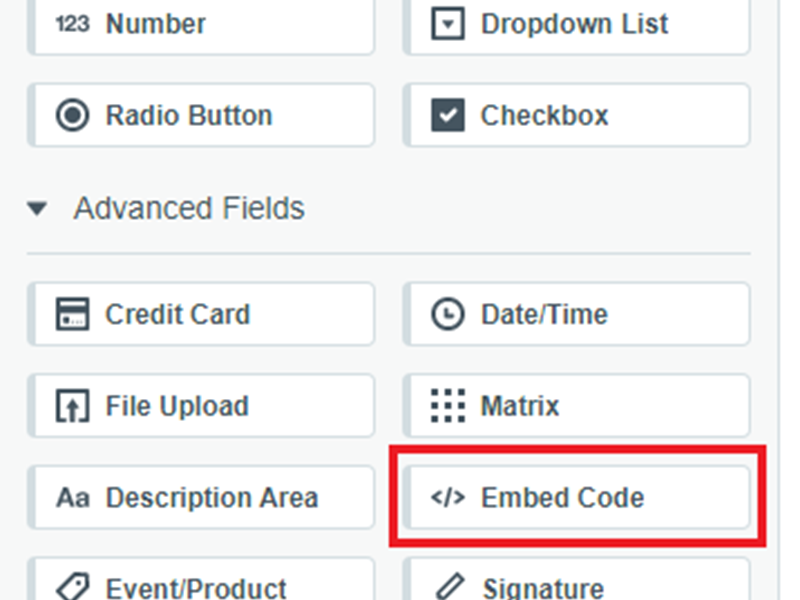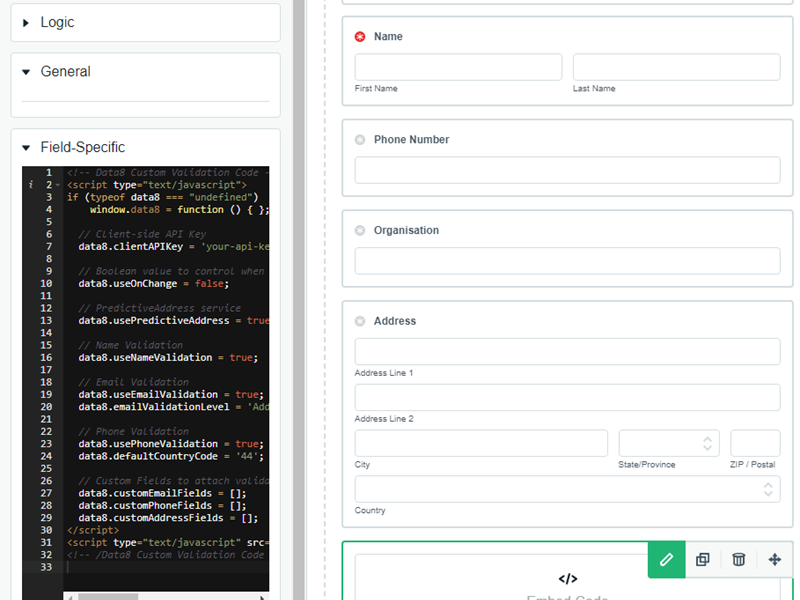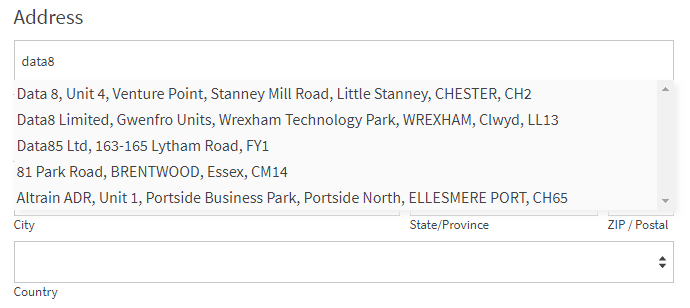Home » Resources » How-to Guides » Formstack Installation Guide
Formstack Installation Guide
Find Data8’s Formstack Installation Guide here to get started with your data validation journey. Our integration for Formstack currently contains integrations for PredictiveAddress, Email Validation, Phone Validation, Name Validation and Bank Validation.
Step 1: add an Embed Code field
To integrate Data8 Validation or PredictiveAddress into your Formstack form, drag an ‘Embed Code’ field onto your form. This can be placed anywhere on your form (start, end etc).

Step 2: Generate your configuration code using the form below
Simply fill out the form and click generate to get your custom code.
Step 3: Paste code in Embed Code field
Having generated your code above, you can now copy and paste this into your Embed Code field.

Additional Configuration
To configure the validation to suit your needs, open the ‘Embed Code’ field and change the value of the variables to suit your needs. An API key is required to use any of the validation or PredictiveAddress services. Each validation service requires the necessary credits to function.
PredictiveAddress Options
When the PredictiveAddress service is enabled, the PredictiveAddress Options box will become visible. This box can be left blank to use the default configuration of PredictiveAddress. However, should you wish to customise your integration, you can do so by entering any combination of the options available for the PredictiveAddress service.
For example, enter the following into the PredictiveAddress options box to detect the initial country in the PredictiveAddress search, from the users IP address:
initialCountry: "auto"
PredictiveAddress & ///what3words
You can search for any 3 word address by simply typing out the three words like so “pitch.tells.civil”.
If you wish to store the 3 word address that was used to retrieve the final address, add the class data8_what3words to an input field to indicate where we should store the what3words address.
If you wish to use what3words to get a more precise latitude and longitude, you will need to pass in the options:
includeLocation: true
includeWhat3Words: true
and then add the classes: data8_latitude and data8_longitude to some text inputs to indicate where to store the returned data.
Using PredictiveAddress with Multiple Address Fields
To attach the PredictiveAddress service to more than one address field, add the data8.customAddressFields = []; option before the closing script tag in the Data8 code. This option takes an array of objects which specify which fields to map PredictiveAddress to (one object per address group). For example:
data8.customAddressFields = [
{
"line1": "address2Line1",
"line2": "address2Line2",
"line3": "address2Line3",
"city": "address2City",
"county": "address2County",
"country": "address2Country",
"postcode": "address2Postcode",
"company": "address2Company"
}
];
Where “address2Line1” is the ID attribute of your line 1 field on the second address group.
You do not need to specify each of the field mappings above for an address. The only required lines are “line1” and “postcode”. The rest can be removed if necessary.
Below is an example of how the option can be used to add PredictiveAddress to 3 address groups (notice the line3, county, country and company lines have been removed from the mapping to match the fields on the example form):
data8.customAddressFields = [
{
"line1": "field76199206-address",
"line2": "field76199206-address2",
"city": "field76199206-city",
"postcode": "field76199206-zip"
},
{
"line1": "field116263591-address",
"line2": "field116263591-address2",
"city": "field116263591-city",
"postcode": "field116263591-zip"
},
{
"line1": "field116263593-address",
"line2": "field116263593-address2",
"city": "field116263593-city",
"postcode": "field116263593-zip"
}];
The Data8 validation in Formstack is compatible with multi-page forms and also with the ‘skip validation between pages’ option.
Usage
After setting up the options to suit your needs, the relevant enhanced data capture and validation will be applied to the appropriate fields on your form. The standard name, email, telephone and address fields will be validated accordingly. Custom/extra fields can be added to the configuration through the ‘custom_..’ variables in the settings.
The following rules can be used to attach Data8 Validation to acceptable fields:
- Email: Either a field name attribute containing
emailor a text input of typeemail, or an id attribute listed indata8_customEmailFields. - Telephone: Either a field name attribute containing
phoneor a text input of typetel, or an id attribute listed indata8_customPhoneFields. - Name: A field name attribute containing
name(excludingusernameandcompany name), the class ‘fsFieldName’ or an id attribute listed indata8_customNameFields. - Address (PredictiveAddress and Postcode Lookup): Field id’s for custom address fields can be added
data8_customAddressFieldsin the following format. (Only ‘line1’ and ‘postcode’ are required):
[{ "line1": "", "line2": "", "line3": "", "city": "", "county": "", "country": "", "postcode": "", "company": "" }]
PredictiveAddress
When PredictiveAddress is enabled, any suitable address entry section on your forms will have use of our address autocomplete and verification tool. Simply begin typing an address/postcode/company name into the Address line 1 or company box to start searching and narrowing down results.


